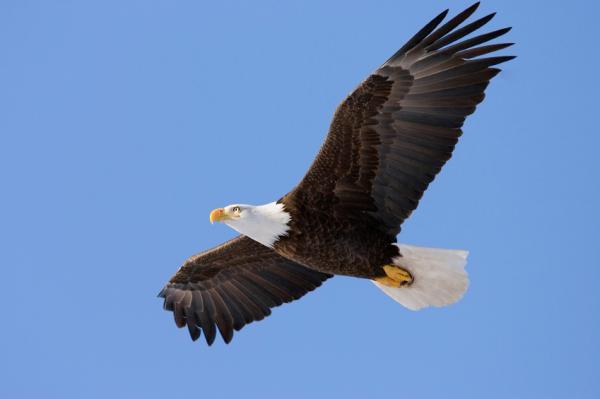Why can't birds reach larger sizes? The largest size record of all flying birds currently belongs to the swan in 15 kg, although scientists previously estimated that Argentavis ancient birds living in Argentina in the Miocene era are up to 70 kg, on par with the average weight of humans. Here in PLoS Biology, Sievert Rohwer and Burke Museum colleagues at the University of Washington will provide evidence that the size of birds is restricted by changing feathers during the fall hair.
As the size of the bird increases, the rate of hair growth cannot keep up with the length of the hair, so there is a time when the hair is falling off before the new hair grows. This relationship requires radical changes in the bird's molt strategy when body size increases, which is the cause of limiting the size of flying birds.

White eagle is flying.What limits the size of birds?
(Photo: iStockphoto / Bruce Leonard)
Through regular exposure to ultraviolet rays and the destruction of bacteria, hair needs to be replaced regularly to maintain the bird's flight ability.Small birds often change their hair from 1 to 2 times a year, of which 9 or 10 feathers are in turn replaced, with a 3-week period for each feather. Large predatory birds often conduct molting once a few years.
With increased body size, the length of the basic feathers will double when the weight increases 10 times. Meanwhile, the time of changing feathers increased by 1.5 times when the body weight increased by 10, until a 10 kg bird would need 56 days to replace a flying feather. The reason for this difference has not been explored, but scientists speculate that it may be due to the geometric character: a 2-dimensional-wide feather structure different from the one-dimensional development structure. of hairy stalks.
Feather is one of the most interesting adaptations in the animal world, and so far there has been little understanding of the dynamic aspect of the development of feathers. It is possible to achieve faster hair growth with a wider hair area, but this will weaken the structure of growing hairs. To understand the technical complexity of the growing feather process, more research is needed on the dynamics and structure of developing regions. What about the old bird Argentavis? The author speculates that this giant bird probably replaces all its feathers at the same time during the long period of starvation, when the body is energized by its stored fat. This is a very similar way to modern emperor penguins.
The research was funded by the Burke Museum, the American Museum, and the University of Washington Department of Biology Casey Award. Donors do not have any involvement in planning research, collecting and analyzing data, deciding to publish results or preparing manuscripts.
Refer:
Rohwer S, Ricklefs RE, Rohwer VG, Copple MM.Allometry of the Duration of Feather Flight Molt in Birds.PLoS Biol, 7 (6): e1000132 DOI: 10.1371 / journal.pbio.1000132
 Animal 'suffering' after hibernation
Animal 'suffering' after hibernation Why do goats climb well?
Why do goats climb well? Scientists were surprised to see chimpanzees eating turtles
Scientists were surprised to see chimpanzees eating turtles Giant catfish died deadly due to drought in Thailand
Giant catfish died deadly due to drought in Thailand